M33
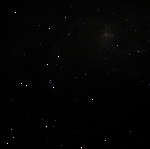 |
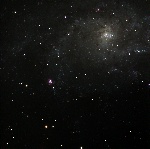 |
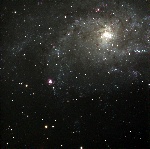 |
| Imax=20 | Imax=4 | Imax=2 |
C14 + ST-4K, 1800s total exposure 10/09/21 Lake San Antonio, CA
This was another test for the C14 + 0.63x reducer combination. M33 is my favorite galaxy to photgraph since it has so many individual stars and nebulae that can be resolved. Here, I centered on NGC604, an enormous emission nebula and star cluster contained within M33. I spent a fair amount of time trying to optimize the focus, eventually choosing a knob setting halfway between points on either side where the stars start to expand. The resolution is clearly a bit sharper than previous attempts, since I can find some close pairs of stars that could not be resolved before.
M33 - Triangulum Galaxy
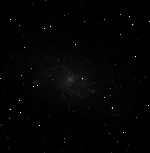 |
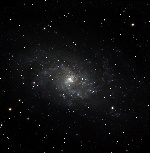 |
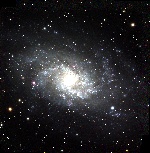 |
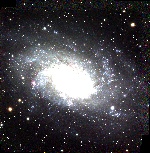 |
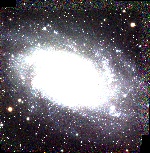 |
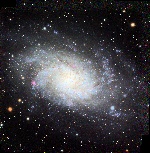 |
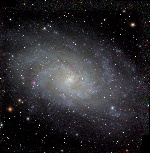 |
| Imax=12 | Imax=3 | Imax=1 | Imax=0.50 | Imax=0.25 | Nonlinear | Nonlinear |
SBIG ST-4K, 9300s total exposure 9/22/17 Whisper Canyon, CA
This was an attempt to get a deeper exposure of M33 (compared with 9/13/12) to see more of the interesting features around the periphery. After discarding a few frames with tracking problems, we ended up with 31 5-minute exposures. The image sharpness is similar to before. There are some regions around the edges that appear more grainy since they have less exposure. I chose not to crop them for increased coverage. The image shows a large number of individual stars, which I think correspond mainly to blue and red supergiants that have luminosities thousands of times greater than our sun. More sun-like stars would be lost in the haze, since a setup such as mine does not have the sensitivity needed to detect them, and no telescope on earth without adaptive optics has the angular resolution needed to resolve them. For me, M33 is the best galaxy to get a sense of the vastness of galaxies, with M31 a close second. For most other galaxies, only Hubble can show this level of detail. (In the Hubble image of M33, the number of stars is quite overwhelming, and globular clusters can be seen.)
M33 - Triangulum Galaxy
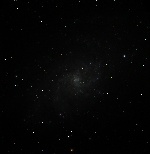 |
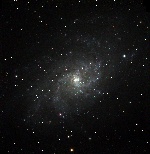 |
| Imax=12 | Imax=3 |
SBIG ST-4K, 1174s total exposure 9/20/17 Whisper Canyon, CA
This was our first attempt at a deeper exposure of M33 for Calstar 2017. The imaging had a good start, with better than average sharpness combined with a diagonal orientation that fits most of the peripheral features into the square field of view. However, after a few frames, the sky suddenly clouded over, and the night was finished.
M33 - Triangulum Galaxy
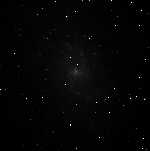 |
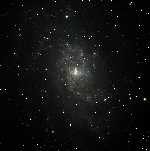 |
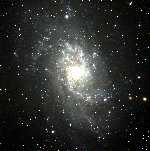 |
| Imax=12 | Imax=3 | Imax=1 |
ST-4000XCM, 2400s total exposure 9/13/12 Lake San Antonio, CA
At a distance of 3 million light years, M33 is one of the nearest galaxies, about the same distance as Andromeda. It is, in my opinion, the most spectacular of all the galaxies for imaging, since it is possible to resolve a large number of individual stars and nebulae. There are globular clusters in the image as well, though it is not obvious how to distinguish them from stars. The brightest emission nebula, appearing at about the 4:30 position relative to the center, is NGC 604.
M33 - Triangulum Galaxy
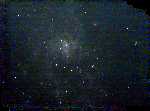 |
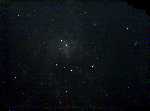 |
| Imax=20 | Imax=40 |
Starshoot DSCI, 97 exposures, 10s each 9/26/08 Lake San Antonio, CA
Like the Andromeda Galaxy, this galaxy is much too large to fit inside the field of view, but it is much more challenging bceause of its low surface brightness. However, there is a much better chance to see individual stars, clusters, and nebulas. This image just shows the central portion. A much longer exposure is needed to really show all of the features in this galaxy.
NGC 604 in M33
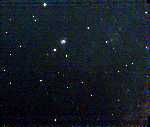 |
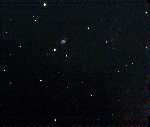 |
| Imax=20 | Imax=40 |
Starshoot DSCI, 60 exposures, 10s each 9/26/08 Lake San Antonio, CA
This is another image of the Triangulum Galaxy, but shifted to the upper-left to show the most prominent nebula in this galaxy, NGC 604. It does not have the red color I expected from photographs I have seen. I'm not sure why, but I notice it also appears smaller than what I saw in some photographs, so perhaps we are seeing only the brightest core of the nebula due to insufficient exposure.